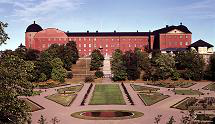Speaker
Dr
Olga Khetselius
(Odessa University -OSENU)
Description
During the past decades the nuclear and optical experiments to detect parity nonconservation (PNC) and hyperfine (hf) structure have progressed to the point where PNC amplitudes can be measured with accuracy on the level of a few % in certain heavy isotopes and significantly worse in some nuclei [1, 2]. Nowadays the PNC in the finite Fermi-systems has a potential to probe new physics beyond the Standard Model. Speech is about an electroweak interaction and PNC in heavy finite Fermi-systems. Here we systematically apply the formalism of the nuclear-QED many-body perturbation theory [3] to precise studying PNC effect in heavy atoms with account for the relativistic, nuclear and radiation QED corrections. The nuclear block of theory is presented by the relativistic mean field model (Dirac-Woods-Saxon model). Earlier an efficiency of this approach has been demonstrated in the precise calculation of the hyperfine structure constants, E1, M1 transition probabilities for some heavy atoms and heavy ions [3]. Here we present the calculated PNC radiative amplitudes for a set of nuclei (atoms): 133Cs, 173Yb, 205Tl, 223Ra with account of exchange-correlation, Breit, weak е-е interactions, QED and nuclear (magnetic moment distribution, finite size, neutron “skin”) corrections, nuclear-spin dependent corrections due to anapole moment, Z-boson ( (AnVe) current) exchange, HFS-Z exchange ((VnAe) current). The weak charge is found for 133Cs, 205Tl and firstly 173Yb and comparison with Standard Model is done. Using the experimental values E/beta=39mV/cm (Веrkeley, 2009; Tsigutkin et al) and our value 9.707 10(-10)eaB, one finds for 173Yb (Z=70, N=103) the weak charge value QW=-92.31, that is compared with the SM QW=-95.44. The received data are compared with known earlier and recent results by Flambaum etal, Johnson etal, Safronova et al. The nuclear spin- dependent PNC interactions due to nuclear anapole moment (ka contribution), Z- exchange interaction from nucleon axial-vector (AnVe) currents (k2), the combined hf and spin-independent Z exchange interaction from nucleon vector (VnAe) currents (khf) are studied. As example, in table 1 we present our results compared with the data on different contributions to the PNC spin-dependent contributions in the isotope of 133Cs (6s-7s), obtained by different groups Safronova etal, Haxton, Flambaum et al [1].
References:
[1]. C Wood et al 1997 Science 275 1759; F Flaumaum, G.Ginges 2005 Phys.Rev. A 72 052115; M Safronova et al 2009 Nucl. Phys. A 827 411; W Haxton et al 2002 Phys. Rev. C 65 045502
[2]. W Johnson, J Sapirstein, S Blundell 1993 Phys. Scr. T46 184; V Dzuba, V Flambaum, M Safronova 2006 Phys. Rev. A 73 022112; V Shabaev et al 2005 Phys. Rev.A 72 062105
[3] O Khetselius 2009 Int. J. Quant. Chem. 109 3330; 2009 Phys.Scr. 135 014023 ; O Khetselius 2013 Advances in Theory of Quantum Systems in Chem. and Phys., Ser. Progress in Theor. Chemistry and Physics, eds. K. Nishikawa, J. Maruani, E. Brandas et al (Springer) 57 217(2012).
Summary
The formalism of the nuclear-QED many-body perturbation theory is applied to a precise studying parity nonconservation (PNC) effect in heavy atoms with account for the relativistic, nuclear and radiation QED corrections. The weak charge is found for 133Cs, 205Tl and 173Yb and comparison with Standard Model is done.The nuclear spin- dependent PNC interactions due to nuclear anapole moment, Z- exchange interaction from nucleon axial-vector (AnVe) currents (k2), the combined hf and spin-independent Z exchange interaction from nucleon vector (VnAe) currents khf) are studied.
Primary author
Dr
Olga Khetselius
(Odessa University -OSENU)

